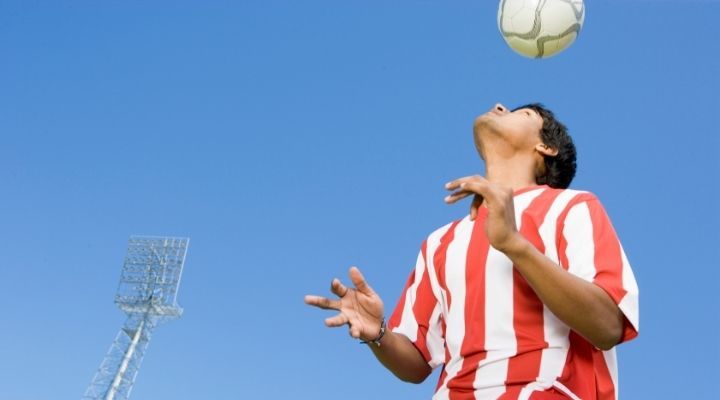How to Play Soccer Tennis (Improve Touch and Creativity)
A fantastic, fun, and fresh new way to hone and improve your skills, soccer tennis will certainly put your first touch and technique to the test.
Played over a small net either indoors or outdoors, the game sees two opposing teams of one, two, or even three players compete to win points and sets against one another.
Because much of the game takes place in the air and at close range, it challenges players' control and creativity as well as their juggling abilities and reaction speed.
This unique, unusual yet utterly engrossing combination of soccer, tennis, and volleyball is a great way to freshen up your team's training sessions while also working on essential parts of their game.
Before looking at the ins and outs of the game, it’s important to note that soccer tennis doesn't have a definitive set of rules due to its informal nature.
There are, however, some general guidelines that most players follow.
And that’s part of its beauty since you can pretty much play anytime anywhere as long as you have a ball with you.
With that in mind, let's first take a look at some of the benefits of playing the game before moving on to its basic rules and guidelines.
We'll then look at some tips and tricks on how to play soccer tennis to the best of your ability.
Why Play Soccer Tennis?
While we brushed on a couple of things that soccer tennis is great for such as reaction times and juggling abilities, there are loads of other benefits of playing the game.
First of all, it hones your control and technique as you have to pass, volley, and header the ball in all types of different situations.
Besides controlling and judging the weight of your aerial passes to your teammates, you also have to be able to powerfully and accurately return the ball over the net to your opponents.
Playing the game also helps you work on your teamwork and communication skills as you have to coordinate together to get the ball back over the net and win points and sets.
Because you’re working in a small space at a close distance to your opponents, you also need to have good positioning and footwork to make sure you don't leave any gaps, get in the way of your teammates, or fall over your feet when trying to return the ball.
On top of being great for touch, technique, and team building, soccer tennis is also fantastic fun and refreshes and relaxes players.
This is because the game helps keep training fresh and focused as it represents a markedly different approach from your normal drills and exercises.
As such, it's no wonder at all that teams such as Barcelona and Bayern Munich sometimes play the game in their training sessions.
With all these benefits in mind, let's now move on to how to play the game!
How to Set Up the Court
While you’d ideally have your own tennis court to play on, you can set up a court just about anywhere with a few cones, bibs, backpacks, or shirts.
Likewise, a net isn’t necessary, although it certainly adds a more challenging and competitive element to the game.
In essence, the court should be set up very much like a tennis court with a net or line of cones dividing the two sides and more cones demarcating the sidelines and baselines.
Due to the informal nature of the game, you can vary the size and dimensions of the court to fit the space and players you have.
You can also make it smaller or larger depending on how easy or challenging you find the game.
In general, each side of the court should measure around 12 metres in length and be about 8 metres wide, though it depends on what you feel comfortable with.
You can set up a court on pretty much any flat surface whether indoors or outdoors with grass being best if you want to do acrobatic overhead kicks!
Basic Rules and Guidelines for Soccer Tennis
There are no defining set of rules for soccer tennis but more of general guidelines and principles that people follow.
Consequently, there are loads of different modifications you can make when you’re playing to make the game more interesting, challenging, or competitive, depending on what you feel.
This could be varying up the court dimensions, not allowing for any bounces, or only using your head to return the ball.
With all this in mind, here are the most common 'rules' that most people follow:

How to Start the Match
To start the game, both teams line up on their side of the court.
While it’s most common to play one-on-one or doubles, you can add as many players as you want depending on how many you are.
To start the match, the team or player with the ball serves it over the net into their opponent's half of the court.
To do this, they can either drop the ball from their hands and let it bounce before volleying or dropkicking it over the net or volley it directly from their hands without letting it bounce.
The player serving the ball should start towards the back of their own court or behind the service box line if playing on a proper tennis court.
They have two opportunities to get the ball over the net and into their opponent's half.
If they fail to do so, then the opposition is awarded a point.
On the kick-off, the opposing team must allow the ball to first bounce in their side of the court before returning it over the net.
How to Play the Match
To return the ball, players can use any part of their bodies apart from their hands and arms.
They can kick, chest, head, thigh, or even shoulder the ball back over the net.
However, the ball must cross entirely over the net before they return it, they can't simply hover at the net just heading it straight back again.
Once the ball arrives in a team's side of the court, it’s only allowed to bounce once.
If it bounces twice, the team loses the point and the opposition is awarded one.
If playing singles, a player is allowed two touches to control the ball and return over the net with one bounce being permitted.
If playing doubles, the two players on a team are allowed three touches and one bounce before they have to return the ball over the net.
But the same player isn't permitted to touch the ball twice in a row before passing to their teammate. They should take alternate touches.
If playing with three players on a team, they’re also allowed to take three touches, with one bounce being permitted.
They should again take alternate touches without any player touching the ball twice in a row.
In all of these cases, teams don't need to take all of their touches or have every player touch the ball before returning it over the net.
A player can decide to simply return the ball over the net with their first touch if they so wish.
While these are the general guidelines that most people follow, you can still play soccer tennis however you like.
If one bounce and one touch per player is too difficult, you can always change it to two touches and two bounces.
Or if it’s too easy, then do away with the bounces altogether.
How to Keep Score
Soccer tennis is just as flexible when it comes to scoring, and teams can play up to any score they like which they decided upon before starting the match.
It’s most common to play up to 11, 15, or 21 points with teams serving for five points in a row before they alternate.
If the game is very tight right at the end, a team needs to win by two clear points such as 12-10, 17-15 or 22-20.
Most people play the best of three sets, meaning the team that wins two out of three wins the entire thing. But this depends on what you decided the rules were before you started the game.
When playing the match, a team loses the point if:
- They let the ball bounce twice on their side
- One player takes too many touches
- They return it into the net
- They return it over the net but outside of bounds
- A player touches the net by accident
- The ball touches a player's hand or arm
- They double-fault on their serve
- The ball bounces on their side first before it goes over the net
Bearing all this in mind, players can be as creative and imaginative as they like in their play, doing overhead kicks and towering headers to power the ball past their despairing opponents.
Soccer Tennis Variations
If these general guidelines are too easy or difficult, then there are loads of different modifications you can use to make the game more fun, challenging, or competitive.
For instance, you can do away with any bounces, make the court smaller, or only permit headers or volleys. This will definitely challenge your players.
If it's already a bit tough, then consider increasing the size of the court and allow for more touches and bounces.
Another fun option is to allow unlimited touches.
This gives you and your team more freedom in your play so you can do tricks, flicks, and bicycle kicks!

Tips and Tricks on How to Play Soccer Tennis
Besides improving your juggling skills, there are a couple of other things to bear in mind if you want to be decent at soccer tennis.
These are your positioning, footwork, and strategy.
Here are a couple of simple tips and tricks to greatly improve how you do out on the court:
1. Stand Back from the Net
Beginners, in particular, are tempted to stand close to the net, but what you want is to take up a position a bit farther back.
This gives you more time and space to react and either pass the ball to a teammate or hit it back over the net.
2. Let It Bounce
If the opportunity arises, it’s always good to let the ball bounce.
This takes the speed and power off of it and makes it easier to control and pass.
By standing farther back from the net, you should give yourself enough space to let the ball bounce.
3. Stay on Your Toes
While the positions you take on the court influence how much space and time you have to react, how you move your feet when you’re called into action is also important.
So, stay nimble and on your toes, ready to pounce and move into position at a moment's notice.
4. Hit the Ball Up
When you pass the ball to your teammate, you always want to hit it up.
This gives them more time to react and either pass the ball back to you or hit it over the net.
Try to use your head as much as possible and set your teammate up for headers over the net since this is easier to do than a volley.
5. Be Patient and Practice
Soccer tennis is very different from the regular game, so don't be disheartened if you find it tough in the beginning.
Just keep practising and in no time at all, you'll find that your touch and technique will greatly improve.
Conclusion
Soccer tennis is not only a great way to hone your touch and technique, but it’s also a great way to keep training sessions fun, fresh, and interesting.
The game is very easy and quick to set up, and it tests players’ touch, control, reactions, agility, and teamwork.
With so many benefits to be gained from playing it, soccer tennis is certainly worth trying out if you haven't already had the chance!

